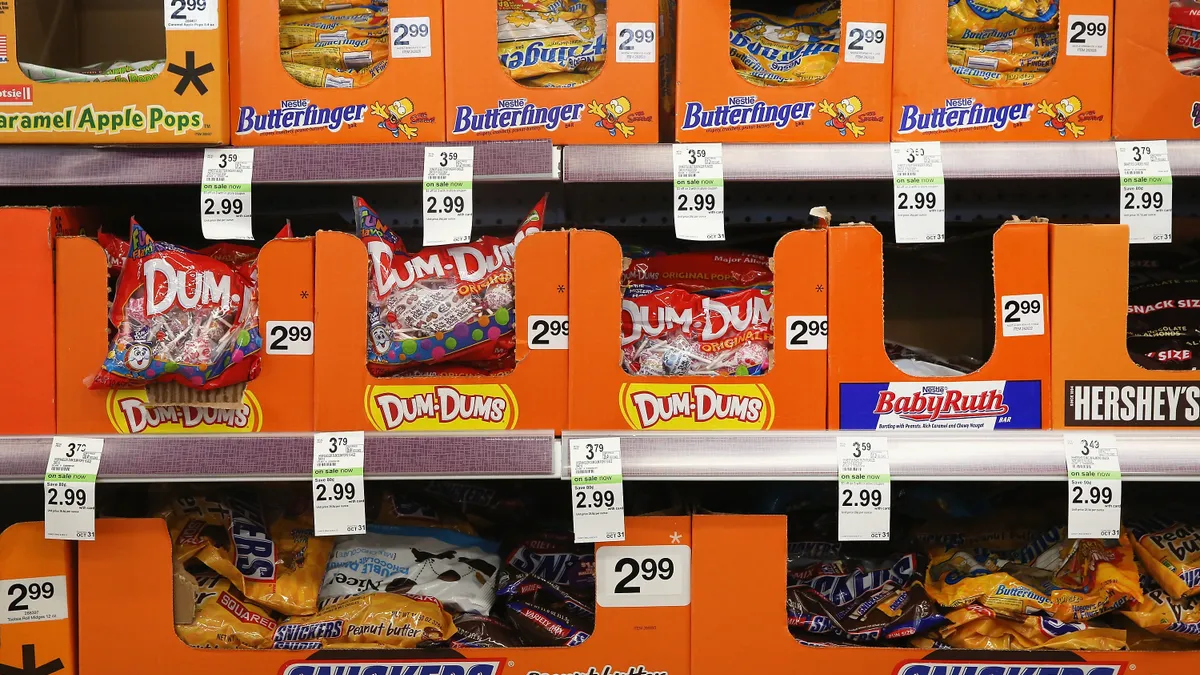Amid a global sugar shortage and record high global prices for the crop this year, industry analysts speculated that the price of Halloween candy could spike as the fall approached. David Branch, senior vice president of Wells Fargo’s Agri-Food Institute, told Food Dive the crop is not causing increased costs for treats. But other factors could be behind the surge.
Halloween candy sales are projected to reach $3.6 billion this year, a 16.1% increase over last year’s $3.1 billion haul, according to National Retail Federation data.
The increased price of sugar has led industry analysts to project heightened prices of candy this year. Costs of the crop have spiked globally since the start of 2023, amid a shortage caused by weather patterns making the climate more dry, particularly in growing regions of India and Thailand. But most of the sugar used in American-made candy is sourced domestically, as federal agriculture policy requires that 85% of sugar purchases come from producers within the U.S.
According to U.S. Department of Agriculture data, the global price of white refined sugar was 32 cents per pound in September, a 35% year-over-year increase from 24 cents last year. But Branch pointed to the U.S. supply of sugar currently being higher than it was in the 2020-2021 growing season, with 300,000 pounds of available supply, according to a USDA report from September.
One reason Branch believes sugar costs will not be the cause of consumers paying more for Reese’s cups and Snickers bars is because U.S. prices of the crop are not necessarily tied to global prices.
“The U.S. has its internal price mechanisms for raw and refined sugar sales,” Branch said. “The global sugar market is closed, it’s not an open, free market. Every major sugar-producing country has their own programs that limit exports and imports and impose tariffs.”
The retail price of sugar and other sweeteners increased 6.5% over the past year, and notched up 0.3% in September compared to the previous month, according to the most recent Consumer Price Index report released by the U.S. Bureau of Labor Statistics. Candy and chewing gum saw 7.5% price increases over the past year, which Branch said indicates the sugar price situation is not having a significant impact on the cost of sweets.
Cash-strapped consumers may actually buy less candy this year, according to Branch.
“What’s really driving candy purchasing estimates this year is more just the general economy. People are holding on to money more and will be trading down from larger candy, buying less or taking advantage of buy-one-get-one-free deals,” Branch said.
The agriculture analyst believes climate conditions are impacting candy manufacturers with a different crop, however. Drought conditions in cocoa-growing countries like Ivory Coast and Ghana has caused chocolate giants like Hershey and Mondelēz International to raise prices on treats this year as they are reliant on those regions for their ingredients.
“When farmers with 15 or 20 acres have bad weather and some of their crop dies, it’s going to be a while for that to get back up,” Branch said. “The price of cocoa is up significantly on a metric ton basis and it’s probably going to stay there for a while.”















